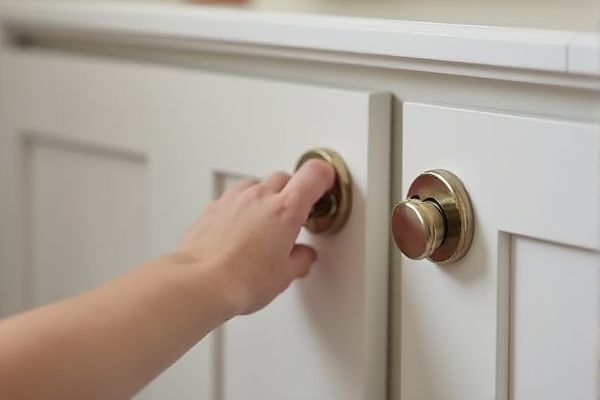
Finger pull latches offer a sleek, handle-free design that allows you to open cabinets with a simple pull, perfect for modern, minimalist spaces. Push latches enable cabinet doors to open with a gentle push, providing a clean look without handles while maintaining easy access; explore the article to find out which latch suits your needs best.
Table of Comparison
| Feature | Finger Pull | Push Latch |
|---|---|---|
| Operation | Pull open using recessed finger grip | Push to release latch, cabinet pops open |
| Installation | Requires precise cutout for finger groove | Mounts inside cabinet, minimal external modification |
| Design | Visible groove, subtle and sleek | Flush, no visible hardware on door front |
| Ease of Use | Simple and direct pull | Push-to-open, convenient for one-handed use |
| Maintenance | Low maintenance, no moving parts | Mechanical parts require occasional adjustment |
| Cost | Generally lower cost | Higher cost due to mechanism |
| Best For | Minimalist, modern cabinetry | Handleless, seamless cabinet designs |
Introduction to Cabinet Opening Mechanisms
Finger pull and push latch cabinets provide efficient opening mechanisms designed for seamless access and ergonomic functionality. Finger pull cabinets utilize recessed grips that allow users to open doors by inserting fingers into a slot, offering a minimalist look and reducing the need for external hardware. Push latch systems operate with a simple press-to-open mechanism, employing spring-loaded catches that release the door without handles, ideal for modern, handle-free cabinetry.
What is a Finger Pull Cabinet System?
A finger pull cabinet system features recessed handles that allow users to open doors or drawers by inserting fingers into a groove or cutout, eliminating the need for external hardware. This design promotes a sleek, minimalist aesthetic while providing easy access and improving safety by reducing protrusions. Finger pull systems are commonly used in modern kitchens, office furniture, and cabinetry to enhance both functionality and style.
Understanding Push Latch Cabinet Technology
Push latch cabinet technology utilizes a spring-loaded mechanism that allows doors to open with a gentle push, eliminating the need for external handles. Finger pull latches feature integrated grooves or cutouts that provide discreet access points for opening cabinets without protruding hardware. Both systems enhance modern cabinet design by promoting sleek aesthetics and seamless functionality in kitchen and furniture applications.
Aesthetic Differences: Finger Pull vs Push Latch
Finger pull cabinet hardware offers a sleek and minimalist look by integrating a subtle groove or indentation directly into the cabinet door, enhancing your kitchen or furniture aesthetic without protruding handles. Push latch mechanisms provide a clean, handle-free surface that opens with a gentle press, ideal for modern, streamlined designs emphasizing simplicity and ease of use. Both options eliminate traditional handles but differ in tactile interaction and visual impact, allowing you to choose based on your style preference and functional needs.
Installation Process: Finger Pull vs Push Latch
Finger pull cabinet installation requires precise cutouts on the cabinet door edge, ensuring a clean and functional grip area without added hardware. Push latch cabinets use a spring-loaded mechanism mounted inside the cabinet, needing accurate alignment for smooth push-to-open operation. Your choice affects installation complexity, with finger pulls demanding woodworking skills and push latches requiring mechanical alignment.
Durability and Maintenance Comparison
Finger pull latches offer enhanced durability due to their recessed design, minimizing wear and reducing the risk of damage over time, making them ideal for high-traffic cabinet use. Push latches, relying on spring mechanisms, may require more frequent maintenance as springs can weaken or fail, impacting long-term functionality. Your choice should consider the balance between low-maintenance durability of finger pulls and the convenience of push latches depending on cabinet usage frequency.
User Experience and Accessibility
Finger pull cabinets offer superior accessibility with a minimalist design that eliminates the need for external hardware, making them ideal for users seeking a sleek, hands-on approach. Push latch cabinets enhance user experience by providing a simple, touch-activated mechanism that requires minimal effort to open, benefiting individuals with limited dexterity or mobility. Both options improve kitchen ergonomics, but push latches typically provide easier operation in high-use environments, while finger pulls prioritize aesthetic integration and immediate grip feedback.
Space and Design Considerations
Finger pull latches save space by eliminating the need for external handles, creating a sleek, minimalist cabinet design ideal for compact areas. Push latches offer a clean look without protruding hardware but require enough internal space for the mechanism to operate smoothly. Your choice depends on balancing available cabinet space with desired aesthetic appeal.
Cost Analysis: Finger Pull vs Push Latch
Finger pull cabinet hardware generally offers a lower upfront cost compared to push latch mechanisms, making it a budget-friendly option for simple designs. Push latches, while slightly more expensive, provide hands-free convenience and can reduce wear on cabinet doors over time, potentially saving on maintenance expenses. Evaluating your project's requirements and frequency of use will help determine whether the initial investment in push latches justifies the enhanced functionality over finger pulls.
Choosing the Right Option for Your Cabinets
Finger pull latches offer a sleek, handle-free design that enhances minimalist cabinet aesthetics and provides easy access with a simple fingertip grip. Push latches, on the other hand, feature a spring-loaded mechanism requiring a gentle push to open, ideal for maintaining a clean exterior without visible hardware. Your choice between finger pull and push latch cabinets should consider ease of use, design preferences, and the level of functionality desired for your specific cabinetry needs.
 homyna.com
homyna.com